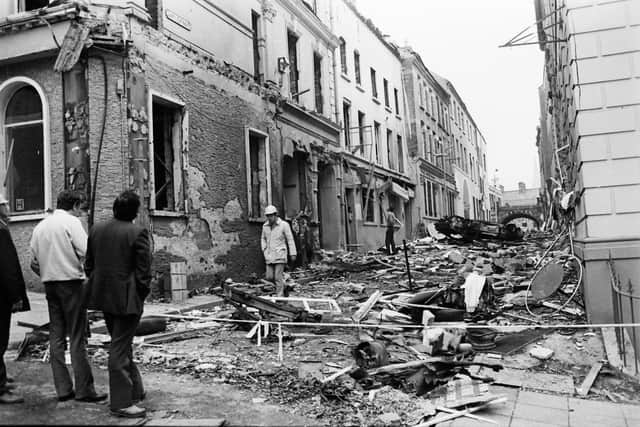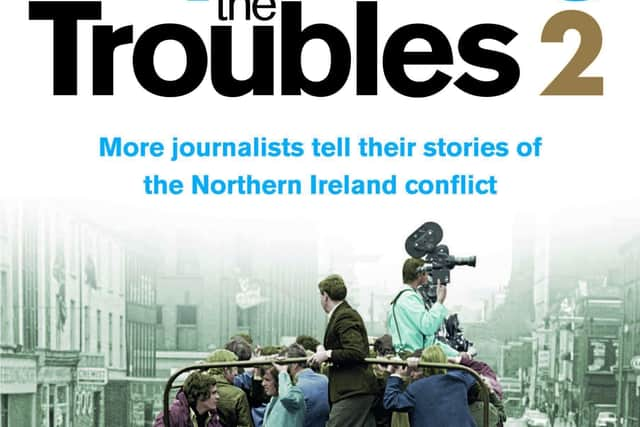A little too close for comfort... standing by a 1,000lb bomb
and live on Freeview channel 276
‘Don’t move, don’t move.’ The words shouted by a British Army officer running towards us were barely audible due to the noise of the rotor blades of the helicopter in which he and a unit of soldiers had just arrived, writes Vincent Kearney.
I was with Willie Carson, a diminutive, charismatic and legendary freelance photographer from Derry, whose work appeared in newspapers, books and magazines across the world. We were standing beside what had been described as a large IRA bomb intended for a passing police or army vehicle. We had heard the helicopter arrive and circle overhead a couple of times before landing in a field a few hundred yards away. We had watched as soldiers disembarked and immediately started running towards us.
Advertisement
Hide AdAdvertisement
Hide AdI asked Willie to take as many photos as possible before we were told to go back outside the police cordon where we belonged.


It all started with what at the time – the late 1980s – was a very routine call to say that a large IRA bomb had been found just outside Derry. I was later told the IRA had alerted a priest or politician – the device had failed to detonate as intended and they were concerned that civilians could trigger it.
I was a cub reporter with the North West edition of the Belfast Telegraph, and Willie Carson was just the man you wanted to be with on a job like this. His local contacts and reputation ensured he could open doors that remained closed to most others.
When we arrived at the RUC cordon, it was on the downward slope of a hill, meaning we couldn’t see what lay beyond. A police officer, who not surprisingly knew Willie, said a ‘very large’ bomb had been left behind the wall of a bungalow, probably fitted with a command wire. I asked if we could walk to the top of the hill to have a look at the scene, while Willie made the point that he needed to see the bomb to be able to photograph it.
Advertisement
Hide AdAdvertisement
Hide AdWillie’s pleas paid off and the officer lifted the white tape, telling us we could have a few minutes. Standing on the brow of the hill, we could see the bungalow a few hundred metres away, but we couldn’t see the bomb, so decided to get closer.


When we arrived at the bungalow we could see two large plastic barrels, each up to slightly above my waist, that had been placed against the inside of the perimeter wall beside the road.
As Willie took photographs, I made a few notes about the scene, the appearance of the barrels and what looked to be a dark powdery substance. It was at this point that the helicopter arrived, and we could hear the officer leading the charge shouting.
Fearing the soldiers might just possibly think we were IRA members rather than curious members of the media, I slowly raised my hands into the air, notebook in one, pen in the other. Willie did the same, waving his camera.
Advertisement
Hide AdAdvertisement
Hide AdThe words being shouted were now much clearer, and more intense, as the army patrol ran at speed across the field that separated us: ‘Don’t f*****g move. Don’t f*****g move.’ We both stood perfectly still until the army unit stopped about a hundred metres away. ‘What the f**k are you doing here?’ asked the officer who had been shouting instructions at us.
I explained that I was a reporter with the Belfast Telegraph, that Willie was a photographer, and that we were simply trying to do our jobs. I offered to show him ID. ‘Why did you break the police cordon?’ he replied, as the unit he led glared in our direction. Not wanting to drop the police officer in it, I said we had been there a while and had not seen a cordon. We were then told we could put our hands down, ‘but stand still’.
‘How did you get into the garden?’ the officer then asked. ‘Which way did you come?’ Pointing to the brow of the hill where we had stood a short time before, I told him we had walked from there down through a field and then through the front gate. ‘Did you touch anything?’ he asked. I explained that we had walked around a little bit to take photographs and make notes but hadn’t touched the barrels.
His next words remain the most chilling I have ever heard in the course of my career: ‘This bomb hasn’t been defused yet.’ Willie and I had looked at each other in shared shock.
Advertisement
Hide AdAdvertisement
Hide Ad‘You got here before us. That’s why there was a police cordon,’ the officer said. ‘Don’t move. There could be pressure plates.’
At that point, two of the soldiers moved towards us, stopping a few metres from the gate. One of them dropped to his knees and began to move forward slowly on all fours, head down and looking closely at the ground in front of him. When he reached the gate, he stood up and asked me to show him where we had walked, and I pointed out the parts of the garden we had been in. He then hunkered down and looked closely at the bases of the barrels that contained a large bomb we had just been told could still be live. The soldier then slowly went back out the gate and told us to follow in his footsteps.
‘Right,’ said the officer when we were back outside. ‘You two, get out of here, now. Go back the way you came.’ We didn’t have to be told twice.
While we had walked down from the hill, it was full speed ahead on the return journey. Given the differences in our height and stride, I made it to the top well ahead of Willie, without once looking back to check his progress. Breathless when we reached the top, we briefly glanced back and agreed that we had just had a very lucky escape.
Advertisement
Hide AdAdvertisement
Hide AdLater, the police said a device containing around a thousand pounds of explosives had been defused.
To this day, I don’t know if there were pressure plates – perhaps the bomb had been planted to take out a police or army patrol but had a faulty firing mechanism, or the telephone warning was a trap to lure soldiers to the scene. I asked those questions, but they weren’t answered.
I don’t know if Willie Carson and I were actually in any real danger. I don’t know if the army officer exaggerated the danger as a result of anger at our actions, and in an attempt to teach us a lesson. If it was the latter, it worked: one thing I do know about that afternoon is that what happened gave me a healthy respect for police cordons.
○ Vincent Kearney is northern editor for RTÉ news. He has also worked for The Sunday Times and Belfast Telegraph.
Advertisement
Hide AdAdvertisement
Hide Ad○ ‘Reporting the Troubles 2’, compiled by Deric Henderson and Ivan Little, features stories from seventy journalists who have worked in northern Ireland during the Troubles. It provides a compelling narrative of the last 50 years and covers many of the key events in NI’s troubled history. It is published by Blackstaff Press.